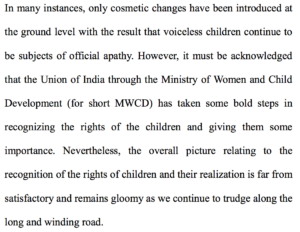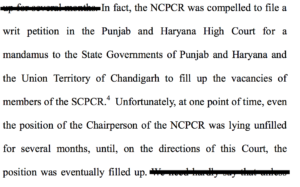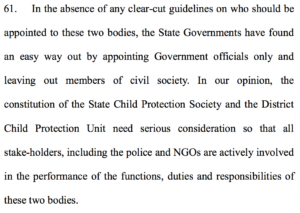Written by Tanvi Mehta
According to the Juvenile Justice Act of 2000, children who commit or are suspected of committing crimes, and are under the age of 18, are too young to be considered as criminals (an amendment in 2015 changed this, and those in the 16 – 18 group can be tried as adults). Deemed as “children in conflict with the law”, “rehabilitative and restorative” treatment is recommended from the moment they are apprehended by police. Under the purview of the Ministry of Women and Child Development, the Act prescribes setting up infrastructure (including a Juvenile Justice Board in every district), properly disseminating funds, and creating a monitoring system for the same. Children found guilty are placed in Observation Homes. Here, by means of institutionalized care, education and vocational training, they are reformed into adults who can abide by the laws and fend for themselves within society.
Despite such institutional mechanisms in place, the implementation of the rehabilitative process seems to have done little to solve the problem of juvenile criminals.
Rehabilitation in a ‘Hell Hole’
Where they do exist, observation homes have been found to be dilapidated and bare, missing basic facilities like potable water and bathrooms and having insufficient clothing, hygiene and food for the children. Often, they are extremely understaffed — at a home in Punjab for instance, one person was both, the sole teacher and administrator. Many homes do not have the provision to send children to school, leaving them either idle, watching television, or enlisted to carry out chores like cleaning, cooking and washing under the guise of vocational training. Officials and NGO workers have observed that this creates a space where violence breeds and little development takes place.

Even when staff are present, reports show clear negligence on their behalf. A TOI report from 2017 exposed that in Noida’s home for juvenile offenders, torture, drugs and extortion were commonplace. Lack of organization and resources mean that Observation Homes are often housed in the same buildings as homes for children otherwise under the state’s protection. It is ironic, then, that the Act from 2000 recommends ‘rehabilitative treatment’ from the moment of the child’s interaction with the justice system; this situation creates exactly the opposite effect.
The result of this hypocrisy? These children quickly turn to violence, drugs, and unlawful activities out of frustration as well as a gloomy realisation that it is the only way of ensuring their survival.
What makes the issue of juvenile convicts more worrying is that the police often process children (even those below 16) into adult prisons, where they learn survival tactics that they generously impart to other children in homes. According to Mr Asthana, a children’s’ rights advocate, surgical blades are often found on juvenile detainees, which is otherwise a common piece of contraband in adult jails. These methods of handling such juveniles catalyse the spread of criminality, instead of nipping them in the bud.
Perhaps, however, what is most shocking is the rampant existence of sexual assault in observational homes – a 2013 Asian Centre for Human Rights report termed these institutions “India’s hellholes” for children, finding a 336% increase in rape cases within observation homes from 2001 to 2011!
Dysfunctional State Mechanisms
The situation on the ground, for its complete lack of effectiveness, can be seen as a reflection of the institutions that preside over it. A 2018 Supreme Court investigation found that positions within both the National Commission for Protection of Child Rights (NCPCR) and various State CPCRs (including the chairperson of the national body) are often left vacant for months on end. In fact, the NCPCR even having had to file a writ petition in the Punjab and Haryana High Courts to nudge authorities to fill up vacancies.

These appointments are usually given to government officials and do not include any other stakeholders in the issue, such as members of civil society or the police. Thus, leadership, when present, is unable to fully understand the challenges of managing the rehabilitation process. Additionally, the dissemination of funds is based on (often inadequately made) budgets provided by the observation homes. The details of these are rarely released, and when they are, include little provision for necessary expenditures like education, counselling or detoxification; one such home even included only ‘tailoring’ as an additional cost!
Thus it is no surprise that institutions for juvenile rehabilitation seem to actually be carrying out the opposite process – not only are state procedures shockingly wanting, NGOs such as ECHO and Healing Dove find implementation a task with little ability to coordinate and no data to help with planning.

The state needs to take a long, hard look at the entire process of juvenile rehabilitation. Evidence that observation homes are mismanaged and don’t actually serve the purpose cannot be denied; a simple google search will show you several news reports to back it up. The reason why rehabilitation is stressed upon by the Juvenile Justice Act 2000, is to ensure that these children have a chance to reform themselves, and become responsible adult citizens of the country. But if homes are not held accountable for the actions that take place within it, then there is no hope for reform. There is no hope for a second chance.
Featured image courtesy YAPI






